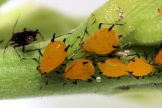
Herbicides, Insecticides & Fungicides… The safer alternatives
There is a rapidly increasing need to change what we spray and sprinkle around the garden to keep it disease and insect free. It has been evident from the first usage of chemically produced sprays and powders that not only do they kill the insect, fungus or weed that is the problem, they also eradicate helpful flora and fauna that are part of the natural biological chain within the garden. Many gardeners do not realize that when top dressing their garden with super phosphate they are systematically eradicating their extremely helpful earthworm population. The same conditions apply when using chemically produced sprays and powders. The garden’s natural biological structure is totally disturbed so instead of combating a problem it is being compiled. The residue of these sprays and powders build up in the soil, getting into your home produced food chain and poisoning the soil for years.
Healthy plants are less susceptible to pest attack, whether it be from insects and other creepy crawlies or fungal problems, such as mildews. The best way to ensure that you have healthy plants is to have healthy and rich soil, full of decaying organic matter, or humus. Add lots of compost whenever you can – not synthetic all-purpose fertilisers that encourage fast and sappy growth. This lush growth attracts pests far more than steady strong growth and they can quickly ravage the plant you have been cosseting so well. Feed your soil, not your plants.
Growing monocultures in nice straight rows becomes a smorgasbord for insect pests. Diversity in your garden acts to confuse insects. (Diversity doesn’t mean dozens of different varieties of roses!). Overcrowding plants may also contribute to fungal problems as air flow between plants is restricted and fungal spores from one plant spread easily to another. Sometimes even the wrong plant for a particular position weakens the plant and makes it more vulnerable to attack. This could be nature’s way of telling you that you need to cull that plant and put in something more suited to the conditions.
If all else fails and you feel you must really reach for something to help a precious plant survive, there are a number of commercially available insecticides, herbicides and fungicides which are considered safer to use in the garden because they are either biodegradable, herbal-based or consist of elements that occur naturally in the soil. They are usually selective in their eradication of pests, killing the ones that are the problem and leaving the useful insects and the soil clean. They may not “zap” your problem instantly, but they have worked for many.
All of the following alternatives can be found in the nursery or at home in the garden and/or kitchen:
Insecticides
Garlic spray: make up your own (see below) or buy some
Pyrethrum: all are readily available commercially, though one additive to the spray, piperonyl butoxide, is not accepted as organic
Eucalyptus
Derris powder
Sulfur preparations (do not use in hot weather)
Mineral oil sprays (make up your own: see below)
“Dipel” or “Success”: Biological control of caterpillars.
Herbicides
Sulfuric/nitric acid: breaks down within minutes after contact with soil and weeds leaving acceptable residues.
Mulching with Newspaper or non-synthetic carpet under felt. Green manure crops in winter are excellent as these will feed the soil when slashed and allowed to decompose.
Black plastic: Effective but excludes air and moisture which is not beneficial.
Marix weedmat: Very effective in controlling weeds yet allow water and air to penetrate its fabric.
Boiling water poured onto weeds can help kill them
Fungicides
Dusting sulfur: Downy and powdery mildew.
Lime/sulfur mix: Powerful, safe fungicide, also effective against scale, red spider and mites.
Copper compound: ‘Bordeaux mixture’ – very effective but use wisely as it kills earthworms.
Blackspot on Roses
1 litre skim milk (preferable organic because it contains more antibiotic qualities)
1 litre soapy water
Spray on foliage every couple of weeks or so, covering both sides of the leaves and the stems.
Powdery Mildew on Soft leafed Vegetables
4 teaspoons bicarbonate of soda
50 mL white oil
4 litres water
Spray foliage as required
Garlic Spray recipe as a general insecticide
(ref Jane Edmanson’s Working Manual for Gardeners)
Crush several cloves of garlic and mix with 2 tablespoons of paraffin oil. Leave to stand overnight. In a separate container, mix 500ml water with 1/3 cup flakes of soft soap. Strain the garlic/oil mix into the soapy water. Store in a glass container, preferable refrigerated and clearly labelled.
This needs to be DILUTED 10 times with water and then misted over your plants. If it is not effective, dilute less. It is not a contact spray, but must be eaten by the pests. It can sometimes also work as a deterrent.
Oil Spray recipe for sap-sucking insects
Use 2 cups of vegetable oil to 1 cup of pure liquid soap and blend them together until the emulsion turns white. Dilute 1 tablespoon of this to 1 litre of water and spray over insects such as scale and citrus leaf miner. NB Only use this in milder weather as the oil film over the plant can burn the leaves. Scale can also be removed using an old toothbrush!
Methylated Spirits
Used straight, dab directly onto small mealy bugs with cotton wool or cotton buds for pests within the crevices. Mealy bugs proliferate in sheltered positions, usually under eaves or in indoor plants.
Snails and Slugs
Seek out their hidey holes. Long strappy leafed plants are a favourite. If you must use snail baits, choose the ones based on chelated iron, rather than metaldehyde, which is also toxic to children and pets. Put some down into the leaves or make traps with the bait inside.
Do the stomp! When it rains, go out overnight with a torch and a sturdy pair of boots and enjoy the crunch as you stomp your way through the garden. You can eradicate hundreds this way!
Place jars half-filled with beer with the mouth at soil level near seedlings and other plants that are susceptible to snail attack. The snails are attracted to the smell of the beer. They consume it, become drunk, fall into the saucer and drown. Use this method only if you can bear sacrificing beer to snails!
Coffee. It’s a great slug and snail killer. Add to 10 parts water, one part espresso coffee. It has to be espresso because instant coffee is just too weak. Spray this solution over the surface of leaves and over the surface of the soil, where snails and slugs might crawl. The snails absorb the coffee through their skin and the caffeine in it kills them.
Snails don’t like to get their foot dirty! They tend not to travel over some substances such as:
Shell grit, as is used for chooks and budgies.
Chopped up hair
Sawdust
Crushed eggshells
Sprinkle them around the base of seedlings and other snail delicacies to keep the snails out
Cabbage Moth
The caterpillars that hatch from cabbage moth eggs can eat a whole row of vegetable seedlings to the ground overnight! To stop cabbage moths laying eggs on your vegie seedlings, scatter empty white eggshell halves amongst your cabbages, broccoli, Brussels sprouts and any other crops that get eaten by cabbage moth caterpillars. These territorial moths mistake the eggshells for other cabbage moths and are repelled from the area.
IMPORTANT SAFETY NOTE
As always, check with manufacturer’s specifications and use safety precautions when using any chemicals – even safer alternatives.





